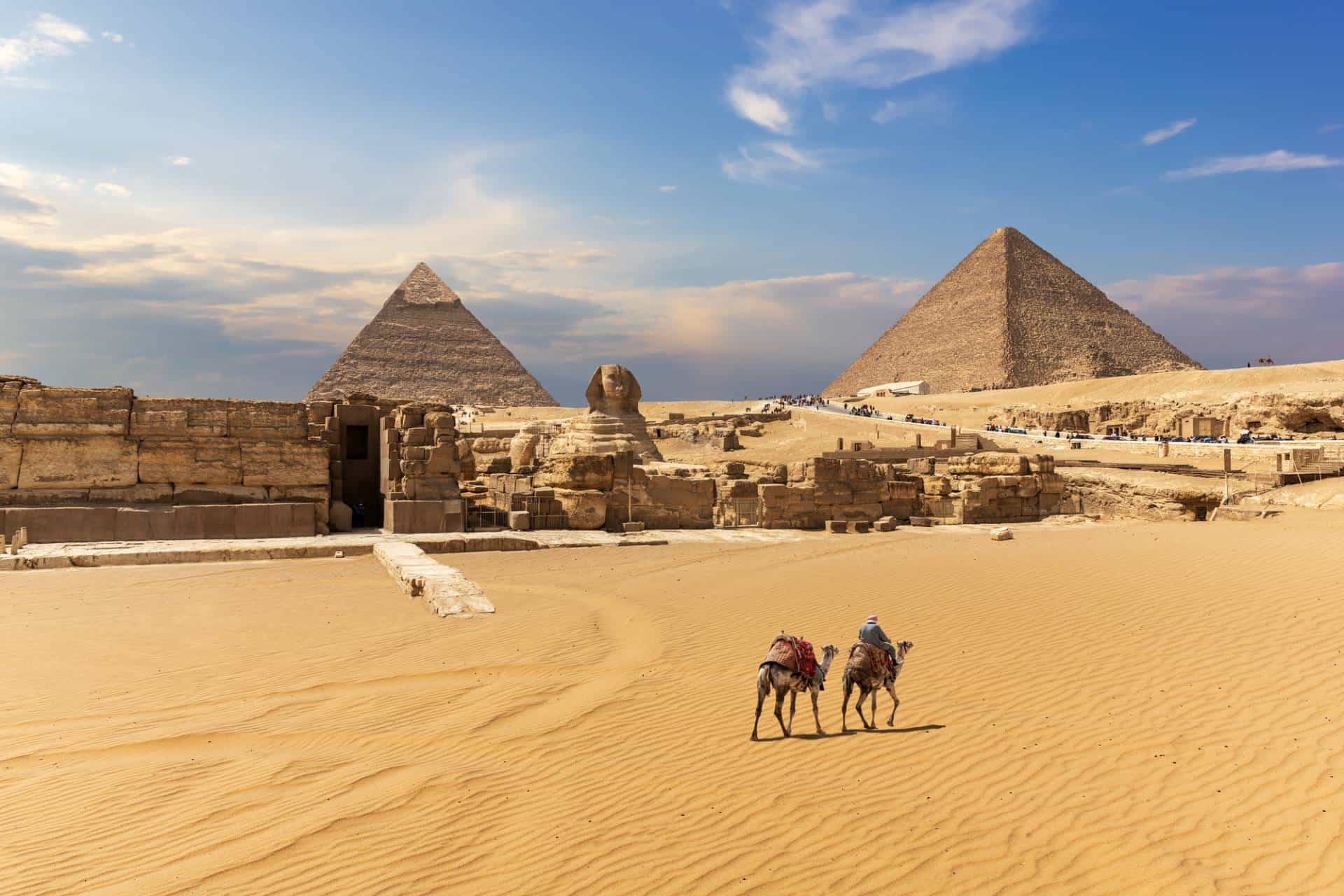
Great Pyramid of Giza to Statue of Zeus at Olympia
The Seven Wonders of the Ancient World, a renowned list of extraordinary architectural and artistic achievements, were first mentioned around 440 BC by Herodotus. Subsequently, Callimachus of Cyrene, Antipater of Sidon, and Philon, a Byzantine mathematician and traveler, further highlighted these marvels. It's essential to remember that this compilation predates many other magnificent constructions like the Taj Mahal, China's Great Wall, or Stonehenge. Compiled over 150 years before Christ's birth, the historians were unaware of these future masterpieces.
- The Great Pyramids of Giza (Egypt): Situated outside modern-day Cairo, Egypt, these pyramids served as royal tombs for pharaohs. The largest, constructed for King Cheops, stands at 450 feet high and contains over 2.3 million stone blocks. Taking nearly 20 years to complete, it remains a testament to ancient engineering prowess.
- The Hanging Gardens of Babylon (Iraq): King Nebuchadnezzar II's gift to his wife, Amytis, these lush gardens stood on the east bank of the Euphrates. Comprising five terraces, they held an array of plants and trees, irrigated by pumps. While not literally "hanging," they were a testament to ancient horticultural ingenuity.
- The Statue of Zeus at Olympia (Greece): Crafted by Phidias, this monumental ivory and gold statue depicted Zeus, the king of Greek gods. Towering at 40 feet, it sat on a throne adorned with golden lions. Located in Olympia, it was a tribute to ancient Greek artistry and religious reverence.
- The Temple of Artemis at Ephesus (Turkey): In the ancient city of Ephesus, this temple was a marvel of ancient architecture. Renowned for its size and intricate decoration, it paid homage to the Greek goddess Artemis.
- The Mausoleum at Halicarnassus (Turkey): This grand tomb, built for King Mausolus of Caria and his wife, Artemisia II, stood as a testament to their legacy. Its exquisite design and rich ornamentation set a standard for future mausoleums.
- The Colossus of Rhodes (Greece): Erected on the island of Rhodes, this colossal bronze statue, depicting the sun god Helios, was over 100 feet tall. Despite its brief existence, it represented the island's resilience.
- The Pharos (Lighthouse) at Alexandria (Egypt): Perched on the island of Pharos, this towering marble lighthouse, constructed by Sostratus of Cnidus, guided ships into the bustling port of Alexandria. Standing at nearly 450 feet, it was a marvel of ancient maritime engineering.
These Seven Wonders showcased the pinnacle of ancient craftsmanship, creativity, and engineering prowess, leaving an indelible mark on human history.
The Seven Wonders of the Ancient World have captivated the imagination of humanity for centuries, representing the pinnacle of human artistic and architectural achievement during their time. Among these, the Lighthouse of Alexandria, also known as the Pharos of Alexandria, stood as a marvel of engineering and one of the tallest structures of the ancient world. Erected in the early 3rd century BC on the island of Pharos, it served as a beacon for sailors navigating the busy harbor of Alexandria, a city founded by Alexander the Great. This wonder was documented by ancient writers like Philo of Byzantium, who praised its towering presence and the technology behind its construction.
Another of the 7 wonders, the statue of Zeus at Olympia, crafted in the fifth century by the sculptor Phidias, was revered not just as an architectural feat but also as a masterpiece of art. This statue, seated within the Temple of Zeus, was so magnificent that ancient visitors were left with the impression that if Zeus were to stand, he would unroof the temple. Unfortunately, like most of the ancient wonders, it was lost to time, with the temple falling victim to a series of earthquakes in the 6th century, highlighting the transient nature of even the most awe-inspiring works of art.
The Mausoleum at Halicarnassus, another of the original seven wonders, served as a tomb for Mausolus, a satrap of the Persian Empire, and Artemisia, his wife and sister. Constructed in the 4th century BC, this structure was so renowned for its architectural beauty and the statues that adorned it that the term 'mausoleum' has since been used to describe grand tombs. Diodorus Siculus, an ancient writer, provided descriptions that allow modern historians to piece together the majesty of this wonder, though it too eventually succumbed to natural disasters.
Not to be forgotten, the Great Pyramid of Giza, the tomb of Pharaoh Khufu, is the only one of the wonders still standing today. Built during the 26th century BC, it remained the tallest man-made structure in the world for over 3,800 years. Unlike the other wonders, which were destroyed by natural disasters or human actions, such as the Temple of Artemis at Ephesus, which was burned down by Herostratus in a bid for fame, the pyramid continues to be a testament to ancient engineering and a connection to the world of ancient Egypt.
These wonders, from the impressive engineering feat of the Lighthouse of Alexandria to the artistic and cultural significance of the statue of Zeus, exemplify the extraordinary achievements of ancient civilizations. Through the remnants and records of these wonders, modern society can glimpse the aspirations, values, and capabilities of the ancients, offering a window into a world where humanity's desire to create and commemorate knew no bounds.
The Seven Wonders of the Ancient World have fascinated historians and travelers alike for centuries, serving as a testament to the ingenuity and artistry of ancient civilizations. These marvels, compiled into a list by ancient writer Philo of Byzantium in the 3rd century B.C., encapsulate the pinnacle of human architectural and sculptural achievement as known to the Greeks. Among these, the Statue of Zeus at Olympia, a masterpiece crafted by the renowned sculptor Phidias in the 5th century B.C., depicted the king of the gods seated on his throne, so immense and majestic that it left the impression that if Zeus arose and stood erect, he would unroof the temple.
Another wonder, the Hanging Gardens of Babylon, said to be built by the Babylonian king Nebuchadnezzar around 550 B.C. for his homesick wife, remains one of the most mysterious wonders, with modern scholars debating its existence and location. According to ancient accounts, these lush, terraced gardens were an attempt to mimic the mountainous landscapes of Media, showcasing an extraordinary example of ancient engineering and botanical knowledge, although no definitive archaeological evidence has yet confirmed their presence.
The Lighthouse of Alexandria, erected on the island of Pharos under the reign of Ptolemy II in the 3rd century B.C., guided sailors safely to the harbor of the ancient city of Alexandria. Known for its towering height and the statue of Zeus sculptor Chares that adorned its summit, the lighthouse was destroyed by a series of earthquakes but remains a symbol of ancient innovation. Its design and functionality marked a significant advancement in building tall structures, influencing later lighthouses and becoming a beacon of ancient technological prowess.
Included in the list of wonders is the Mausoleum at Halicarnassus, a monumental tomb built for Mausolus, a satrap of the Persian Empire, around 350 B.C. This structure, renowned for its architectural beauty and the artistic sculptures that adorned it, was so celebrated that it influenced the design of tombs well into the Roman era. The Mausoleum stood as a testament to the blending of Greek, Egyptian, and Lycian design and artistic elements, embodying the cultural exchanges of the ancient world.
These wonders, from the colossus that guarded an island city to the gardens that supposedly floated in mid-air, the giant tomb of an Asian ruler, and the seated image of the chief god of the Greeks, each represent the extraordinary achievements of the cultures that built them. Though all but one of the seven wonders have since been destroyed, their legacy endures through the lists of wonders that have been passed down through history, inspiring awe and wonder about the ancient world's capabilities.
The Seven Wonders of the Ancient World, a list that has captivated the imaginations of people for centuries, includes marvels like the majestic Hanging Gardens of Babylon. These were said to be built around 600 B.C. by King Nebuchadnezzar II, one of the most powerful rulers of the ancient world, who aimed to recreate the lush landscapes of his queen's homeland. As one of the seven ancient wonders, the Hanging Gardens symbolize the extraordinary achievements of ancient civilizations, showcasing not just architectural and horticultural expertise but also the profound human desire to create beauty and wonder. This aspiration to transcend the ordinary is a common thread that connects all the seven wonders of the world, each a masterpiece that reflects the remarkable capabilities and ambitions of the ancients.
The Seven Wonders of the Ancient World have long fascinated historians and travelers, each wonder showcasing the remarkable achievements of the ancient known world. Among these, the Temple of Zeus at Olympia held a statue of the Greek god Zeus, which was an exemplary work of the sculptor Phidias. This magnificent statue depicted the god seated on his throne, made from gold and ivory, reflecting the grandeur and skill of ancient craftsmanship. The awe it inspired was such that it was said if Zeus stood, he would unroof the temple. This wonder not only represented the artistic and religious aspirations of the Greeks but also stood as a testament to the advanced sculptural techniques of the ancient world.
Another celebrated wonder was the Tomb of Mausolus in Halicarnassus, built around 350 B.C. It served as the final resting place for Mausolus, a Persian satrap, and was constructed under the watchful eye of his grieving widow, Artemisia. The structure's architectural elegance and the detailed sculptures that adorned it made it a masterpiece of the ancient world, influencing the design of monuments for centuries to come. The tomb's significance was such that it introduced the term 'mausoleum' into many languages as a word for a grand tomb.
The Gardens of Babylon, built around 550 B.C. by the ancient Babylonian king Nebuchadnezzar II, were a marvel of ancient engineering and horticulture. According to legend, these terraced gardens were lush with exotic plants and flowers, watered by an ingenious irrigation system. Though their existence has been debated, they remain a symbol of the opulence and ingenuity of ancient Mesopotamian civilization. This wonder, like others, reflects humanity's timeless pursuit to harmonize with and embellish the natural world.
Intriguingly, the ambitions of the Roman Emperor Caligula reportedly led him to order the removal of the heads of statues of these wonders, intending to replace them with his own likeness. This act of hubris aimed to align his rule with the greatness of the ancient wonders, underscoring the enduring influence of these marvels on leaders and civilizations that followed. The original list of wonders, compiled by ancient historians like Diodorus Siculus and later added to by artists like van Heemskerck, captures the imagination of each era, from the opulence of ancient civilizations to the curiosity and reverence of later ages, including our own. These wonders, ranging from architectural feats to artistic masterpieces, continue to be celebrated as pinnacle achievements of human creativity and ingenuity, inspiring awe and wonder across millennia.










